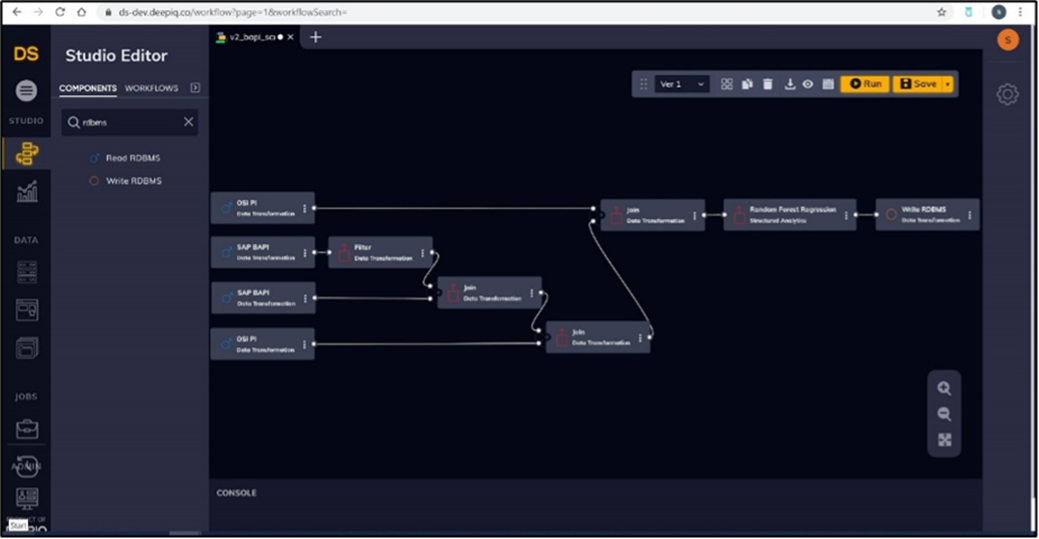- Are you frustrated with IT/OT data integration related challenges?
- Do you feel that you are not getting enough value out of your maintenance and real time operational data?
- Do you wonder when people will start talking about the real benefits of predictive maintenance?
If your answer(s) are yes, then don’t worry – you are not alone! A recent survey by Bain & Company shows that more than 30% of industrial companies are concerned about IT/OT integration. Another recent report by McKinsey & Company states that 70% of companies are still in “Pilot Purgatory” mode. Clearly, the implementation of industrial analytics is not a trivial task – whether it’s IT/OT data integration or building machine learning (ML) models for predictive maintenance purpose.
DeepIQ’s DataStudio software is built with one motto – Self Service Analytics for the Industrial World. The application, in the truest sense, offers self service capabilities. You can:
- deploy the application in hours – develop machine learning models in days – realize value in weeks
- harness cloud’s distributed computing capability for 50x performance gains
- auto-scale for industrial data volumes: from kilobytes to petabytes
- leverage industry leading library of analytics for OT data to build the most accurate advanced analytics model for predictive maintenance.
- deploy on cloud platform of your choice – AWS, Azure or Cloudera
- use for any industrial data analysis
DataStudio’s built-in connectors for industry standard data historians (e.g. Pi System from OSIsoft) enable seamless fetching of time series data, data cleansing, and data preparation for ML model building exercises and real time execution of validated models. Similarly, the wide range of relational data connectors (e.g. SAP-Plant Maintenance) makes the data import a trivial task. The user-friendly, drag-n-drop functionality, coupled with built-in sophisticated mathematical functions, empower you to manage your data at ease – right from merging of multiple data streams to data cleansing, including building supervised and/or unsupervised ML models. The wide choice of classification and regression algorithms, along with numerous switches in each of them to augment the accuracy of your model, ensures that you implement the best ML models for accurate performance predictions.
You can fully leverage Pi System’s Asset Framework (AF) structure to extract the right data at the right frequency for your analysis, and subsequently blend that with the selected columns from maintenance records in SAP-Plant Maintenance (SAP PM) to generate aggregated data sets with appropriate markers for segregating pre-failure, pre-preventive maintenance and post-restart datasets. BAPI based SAP connector simplifies the data extraction task tremendously. These features significantly accelerate your preparation time to start building models to days, instead of weeks or months. If you are already reaping the benefits IT and OT data integration through SAP Manufacturing Intelligence and Integration (SAP MII), then you can increase the returns on your investment (ROI) by adopting the ML module of DataStudio.
DataStudio offers a perfect environment for collaboration between an organization’s entire Digital Team – Data Scientists, Subject Matter Experts and Information and Operations Software Teams. Each persona can perform his/her tasks and contribute to the overall project delivery with maximum efficiency. As the entire data processing step is performed within the application itself, and not in Excel, there is no loss of knowledge and/or information between model building or validation exercises and the real time execution of the analytics model. This and many other functionalities of DataStudio are developed primarily to help Digital Teams manage the change in the organization during the software roll out phase.

Use case
Heat exchangers are widely used in multiple industries including oil & gas, chemicals and power. The overall performance efficiency of the heat exchanger depends on multiple components – hot and cold fluid properties, configuration of heat exchanger, preventive maintenance schedule.

- Data Cleansing: Typically, the high frequency sensor data (pressures, temperatures, etc.) has many data quality issues including missing data, noise and outliers. DataStudio allows you to address all of these concerns using pre-built time-series analytic components. You can impute for missing data, remove outliers, and smooth out high frequency noise using a choice of algorithms that are best suited for your data. The audit trail feature of DataStudio ensures that your cleansing workflow is preserved for the subsequent on-line deployment of the ML Model. This helps you alleviate false alerts and augment the confidence level in the predictive maintenance system
- ML Model Building and Validation: Selecting the right quality and quantity of data at right frequency plays a vital role in the performance of your ML model. DataStudio’s data aggregation, dimensionality reduction, visualization and variable dependency functionalities empower your data scientists and subject matter experts to perform this task efficiently. Your subject matter experts can easily bring in the physics of the process in the model building exercise – e.g. overall heat transfer coefficient or heat rate calculations. Finally, the grid search component of DataStudio allows you to train using thousands of model hyper parameters and select the one that is most optimal for your data.
- ML Model Execution: You can execute your ML model(s) in a batch or streaming mode to generate intelligent alerts. DataStudio is a lightweight application but performs heavy duty tasks – for batch operations it can handle your petabytes of data and for streaming, your millions of messages per second. It also leverages the cloud’s computing power to perform your tasks at lightning speed.
- ML Model Updates: As new data is generated, your workflows will continue to monitor model performance against them. You can schedule your training workflows to retrain your model on a scheduled basis to periodically update your models.
- Real Time Visualization, Alerts and Reports: You can use the application of your choice such as Spotfire or Tableau to visualize actionable insights from your Pi System and SAP PM data. You can also use streaming visualization software like Ignition or Power BI to see results in real time.
After following these five steps, you can get real time alerts on the condition of your heat exchangers and successfully transition from preventive or reactive maintenance to predictive maintenance.

